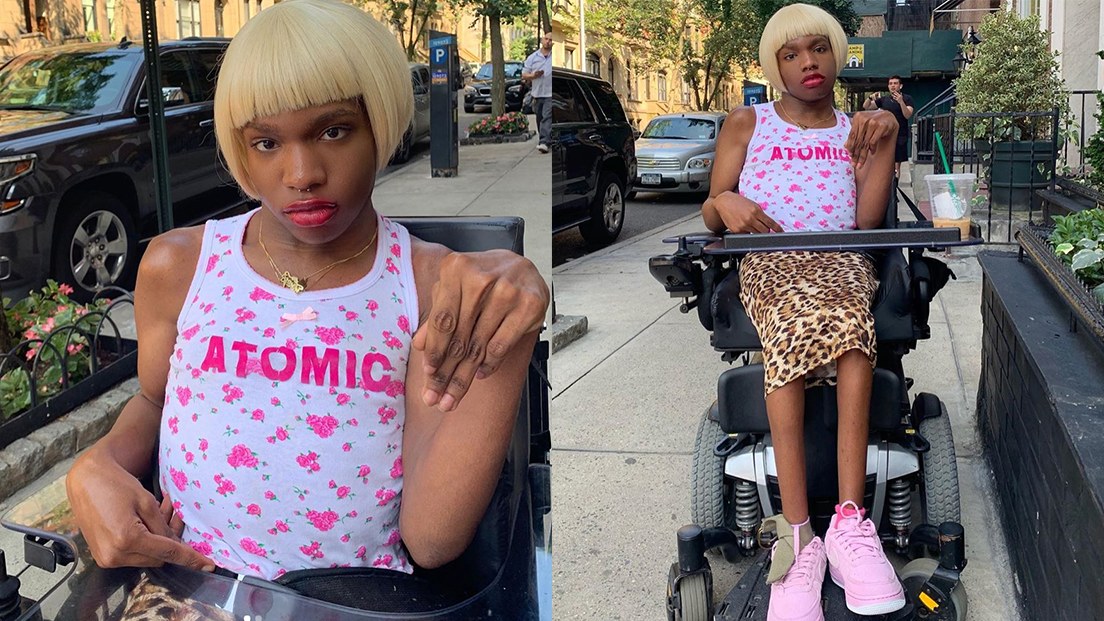Model Aaron Philip Celebrates Red Lipstick and Her Disability

The process of applying lipstick often requires little more than muscle memory. Some outline their lips for precision. Others do a casual swipe and blot. It’s a routine one could easily take for granted, but Aaron Philip doesn’t. The Antigua-born 18-year-old is now based in New York, where she’s broken boundaries as the first black, transgender model with a disability to be signed by a major agency (Elite Model Management). Her meteoric rise over the last several months has seen her grace the cover of Paper magazine, land her first New York Fashion Week show, and graduate high school in June. The model, who was born with cerebral palsy, has also made a point to apply her own lipstick along the way. And through the seemingly commonplace task, she has found new ownership over her identity. This is her story, as told to writer Gina Marinelli.
I’d never gotten into makeup until this past year, when I started experimenting with my look. I didn’t care for it much because I wasn’t comfortable enough with myself to do so. As a person with a disability, I had no idea what I would be in for or what I was doing. And as someone with intercepting identities, I had to look inward and find where I would be comfortable with makeup. This past Fashion Week back in February, I had an awakening.
I finally felt comfortable enough to revamp my image and—even though femininity and masculinity are a construct—start looking more traditionally feminine. I wanted to resemble Sky Ferreira, Blondie, Courtney Love, and Foxy Brown. I bleached my hair and eyebrows. I also wanted to look like Island ladies because a lot of women tend to wear lipstick in the Caribbean. I combined all the things I love into the way I project myself to the world.
I actually bought my first lipstick weeks before my high school graduation. My ex-paraprofessional went with me to Sephora one day and got me MAC Red Lipstick. It was my graduation gift, and I couldn’t wait to wear it.
June was busy for me because of Pride Month. I was constantly getting my makeup done and spent a month with that lipstick in my bag. When you have others doing your makeup all the time—for events, photoshoots, bookings—you start to take notice. They line my lips before they fill them in, and they keep going over until the color pops. They use a lot of reds and purples, the types of colors that complement my skin tone. I don’t even think they notice that I’m noticing everything.
One day, when I finally had some downtime with my best friend, I tried applying it by myself for the first time. We were in her apartment on the Upper West Side in New York City just having a girls’ day. She pointed out that she had I handheld mirror I could use, so I pulled out my red lipstick.
My disability is physically very spastic. It can be hard to move my muscles in a way that I want to. It’s not fluid or easy to do things like lift up my hand to my mouth. It’s always easier when I’m in front of a mirror. The hardest part is lining my lips because I don’t want to get it all over my face, but I learned how to master that. Then I just fill in my lips and make sure they look even. If you want to make it spicy, you can put a gloss on top.
After that time, I did my lipstick on the way to a party a couple weeks ago. I combined my MAC lipstick with my Marc Jacobs lip gloss for that glossy, lush color. I wanted to share it on social media—my community online, these are my loved ones. I learned how to do something that’s important to me, and I care enough about them to share this part of me.
I don’t get the opportunity to talk that much about disability, but I realize how important it is that I do. When I talk about it, people understand my everyday life. Lipstick is now becoming part of that everyday life. I’m practicing. As a person with a disability, makeup is not easy, but I’m learning how to work my way around it. I’m having fun; it’s not a burden or a problem. I want to celebrate beauty and disability. People with disabilities are often made to not feel beautiful; people think that we can’t do things that make us feel beautiful, but that’s untrue. I hope other people—other women with disabilities, especially—can find some solace in my story. I know it can be hard.





